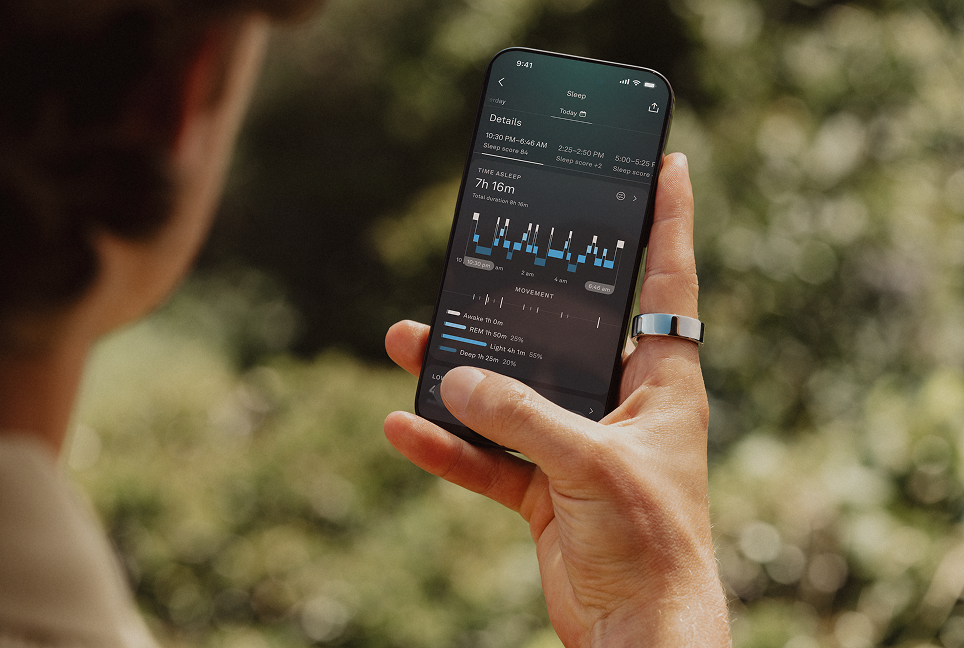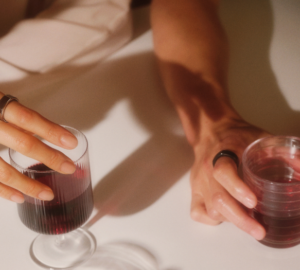- Wondering how to increase your oxygen level immediately? Try standing up, get some fresh air, and take some deep breaths. To increase blood oxygen over time, focus on getting enough sleep, improving indoor air quality, practicing breathwork, and exercising.
- If your blood oxygen levels drop below 90%, it could indicate that there is something challenging your body. It’s important to speak to a healthcare provider, but you can also try lifestyle strategies to improve your levels as well.
- With the overnight Blood Oxygen Sensing feature in Oura Ring Gen3, Oura members can obtain crucial insights into their heart and lung health, helping them understand how to increase oxygen levels while sleeping.
The term “blood oxygen levels” refers to the amount of oxygen circulating in your blood. Although normal blood oxygen levels vary from one person to another (check with your doctor about your healthy range), typical healthy oxygen saturation ranges from 95% to 100%.
Oxygen is vital for every organ and system in your body, and if your blood oxygen levels drop below 90%, it might indicate that there is something challenging your body. In this case, you need to speak with a healthcare provider.
With the overnight Blood Oxygen Sensing feature in Oura Ring Gen3, Oura members can obtain crucial insights into their heart and lung health.
Why is My Oura Ring Red?
You may notice that your Oura Ring sometimes has a red light. This is how it monitors your blood oxygen levels. When your Oura Ring detects that you might be asleep (but it can also happen during the day), it shines red and infrared light onto your finger.
The reflected light that bounces back indicates how much oxygen is in your blood. In the morning, check the Sleep tab in your Oura App, where you can see your Average Blood Oxygen reading and Breathing Regularity graph.
READ MORE: Inside the Ring: How We Developed the Blood Oxygen Sensing (SpO2) Feature
Potential Causes of Low Blood Oxygen Levels
Low blood oxygen saturation can have many different causes, ranging from health conditions to environmental factors. Here are nine of the most common.
1. Poor Lung Health
Respiratory diseases, such as chronic obstructive pulmonary disease (COPD — also known as emphysema), asthma, and pneumonia, can impair the lungs’ ability to exchange oxygen and carbon dioxide, leading to lower blood oxygen levels.
RELATED: Understanding Your Respiratory Rate
2. Anemia
Red blood cells contain hemoglobin, which carries oxygen throughout the body. People with anemia don’t have enough hemoglobin, which limits their body’s capacity to keep enough oxygen in the blood.
3. Circulatory Problems
Conditions that affect the heart and blood vessels can impact the transportation of oxygen-rich blood to body tissues.
4. Sleep Apnea
The pauses in breathing or shallow breaths during sleep that people with sleep apnea experience can disrupt the oxygen supply, leading to decreased blood oxygen levels during the night.
READ MORE: Sleep Apnea, Defined — And How to Treat It

5. Chronic Hypoxemia
Chronic hypoxemia refers to the long-term condition of low blood oxygen levels. It can be caused by various underlying health conditions, including lung diseases, heart diseases, and sleep disorders. Chronic hypoxemia may require medical interventions such as oxygen therapy to improve oxygenation.
6. Smoking
Smoking damages your lungs and affects your respiratory system’s ability to efficiently oxygenate the blood, leading to lower blood oxygen levels.
7. Environmental Pollution
Exposure to air pollutants such as carbon monoxide, sulfur dioxide, and particulate matter can impair lung function and decrease oxygen uptake. Prolonged exposure to polluted air can contribute to lower blood oxygen levels over time.
8. Medications
Certain medications, such as opioids and sedatives, can depress the respiratory system and cause shallow breathing, resulting in decreased oxygen intake and lower blood oxygen levels.
9. Altitude
At high altitudes, the atmospheric pressure is lower, so there’s less oxygen available in the air, and your body has to work harder to keep your blood oxygen at optimal levels. After a while, your body acclimatizes, but until it does, your saturation may be lower than usual.
What are Symptoms of Low Blood Oxygen Levels?
Consult your doctor if you’re experiencing two or more of these common symptoms associated with low oxygen saturation:
- Shortness of breath
- Headaches
- Dizziness
- Restlessness
- High blood pressure
- Lack of coordination
- Chest pain
- Elevated heartbeat
| Member Tip: By monitoring your heartbeat throughout the day and night with your Oura Heart Rate Graph, you can detect any deviations from your average resting heart rate. |
Additionally, chronic low blood oxygen levels can cause other health problems over time, such as kidney failure, brain damage, and even life-threatening heart arrhythmias.
How to Increase Oxygen Levels Immediately
Increasing blood oxygen levels immediately can be crucial, especially in emergency situations. Here are a few methods to increase oxygen levels immediately:
- Take some deep breaths: Deep, slow breaths can increase oxygen intake. Techniques such as diaphragmatic breathing or pursed-lip breathing are effective.
- Change your position: Sit up straight or stand up to help improve lung capacity. The “tripod” position (sitting and leaning forward with elbows on knees) can also aid in breathing.
- Use an oxygen mask: In some cases, you might benefit from using supplemental oxygen through a mask or nasal cannula to increase oxygen levels immediately.
- Drink some water: Drinking plenty of water keeps your lungs well-hydrated, enhancing their capacity to oxygenate your blood and expel carbon dioxide efficiently.
- Get some fresh air: Move to an area with better ventilation or step outside for fresh air, which can help you quickly replenish your oxygen level.
10 Ways To Improve Your Blood Oxygen Levels Over Time
The best way to increase oxygen levels in the blood will depend on the cause, which is why it’s essential to talk to your doctor if you think your blood oxygen is too low. However, the following 10 tips can help improve your blood oxygen levels and overall health.
1. Get Enough Sleep
Getting enough good-quality sleep is essential for your body’s rest and recovery. It’s also one of the most effective answers to how to increase oxygen levels while sleeping. It also optimizes blood oxygen, as it can help improve lung function, thus increasing blood oxygen levels — especially relevant if you’re wondering how to increase oxygen levels while sleeping.
Start by consulting your daily Sleep Score in the Oura App and tracking your sleep trends in the Trends tab. This will provide a picture of your average sleep quality and duration, as well as information on how to improve them. Oura will also provide guidance around your ideal bedtime and chronotype so you can optimize your sleep schedule according to your body’s unique rhythms.
READ MORE: 5 Ways to Upgrade Your Sleep Hygiene
2. Stay Hydrated
Drinking enough water helps maintain blood volume and viscosity, ensuring that it flows properly and delivers oxygen to your cells and tissues.
3. Eat Iron-Rich Foods
Incorporate foods into your diet that are rich in iron, which is essential for creating hemoglobin, and vitamin C, which helps the intestines absorb the iron your body needs to make hemoglobin. Examples include leafy greens, cruciferous vegetables, berries, citrus fruits, lean meats, and legumes.
4. Exercise Regularly
Exercise helps to strengthen your heart and lungs. This can improve your circulation and help to deliver more oxygen to your tissues. Use your Readiness Score and daily Activity Goal to find the ideal balance between exercise and rest.
5. Improve Your Indoor Air Quality
Ensure you have good indoor air quality by regularly ventilating living spaces, using air purifiers, and minimizing exposure to indoor air pollutants like smoke, dust, and chemicals. Breathing clean air improves oxygenation and overall respiratory health.
6. Get More Fresh Air Throughout the Day
Opening your windows while at home or going outside for a walk can increase the amount of oxygen available to your body, which increases your overall blood oxygen level.
7. Incorporate Breathing Exercises
Practicing breathing techniques, such as diaphragmatic breathing or belly breathing, can help expand lung capacity and increase oxygen intake. Studies have shown that pursed-lip breathing is particularly effective in alleviating symptoms of COPD.
| Member Tip: Head to Explore content in your Oura App to access guided breathwork exercises and receive a biofeedback report after every session that shows changes in your heart rate variability (HRV), resting heart rate, and skin temperature. |

8. Don’t Smoke
Smoking damages your lungs, makes it difficult to breathe, and leads to low blood oxygen levels. For smokers, quitting can lead to improved blood oxygen levels.
9. Manage Your Medical Conditions
If you have a health condition that affects your blood oxygen levels, such as asthma, it’s important to manage your condition. This may involve taking medication, making lifestyle changes, or both.
| Member Tip: Use the Tags feature in your Oura App to track symptoms, lifestyle choices, habits, and behaviors, and see how they affect your well-being over time. Turn on Rest Mode on days when you don’t feel well — this will automatically deactivate your daily Activity Goal. |
10. See a Healthcare Provider
If you are concerned about your blood oxygen levels, it is important to seek medical attention. Your doctor can help you determine the cause of your low blood oxygen levels and recommend treatment options — for instance, if you have sleep apnea, they may prescribe a CPAP machine to help you breathe more easily at night.
RELATED: 8 Ways to Improve Your Cardiovascular Health
The Oura Ring is not a medical device and is not intended to diagnose, treat, cure, monitor, or prevent medical conditions or illnesses.













